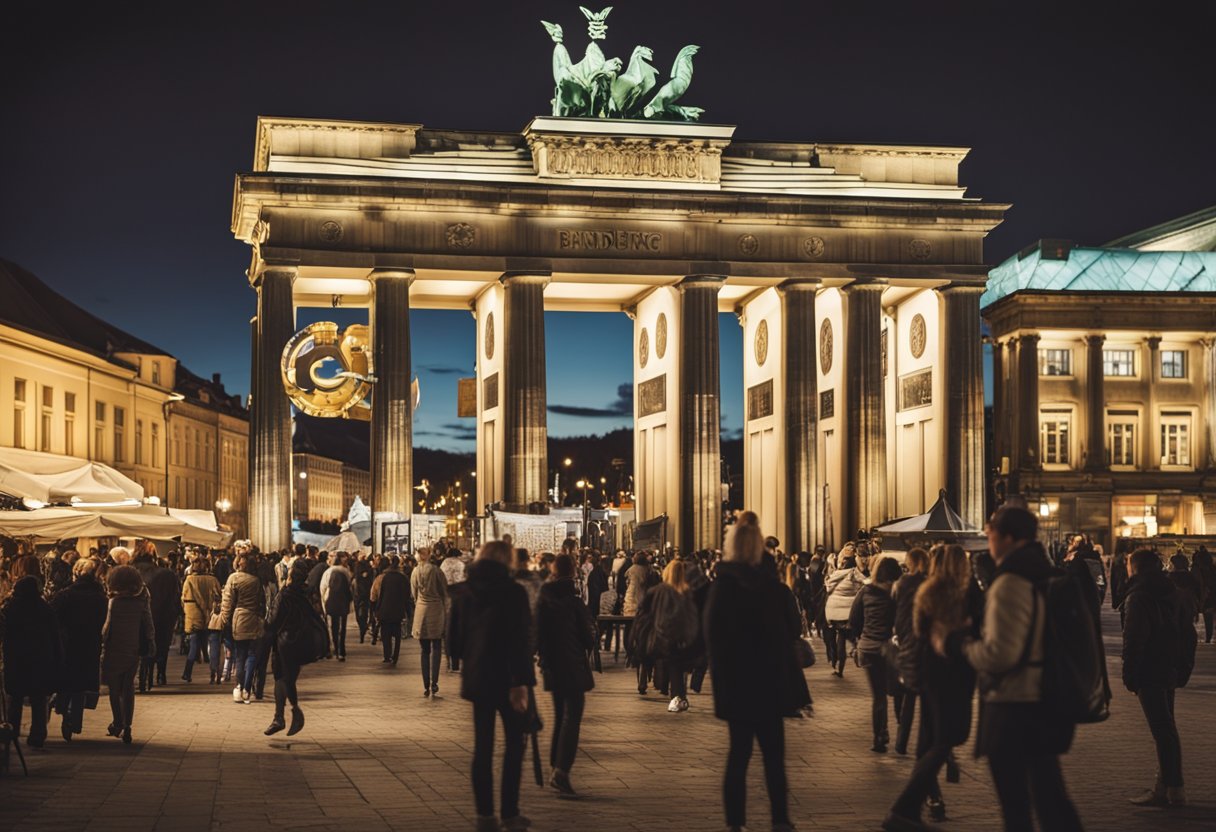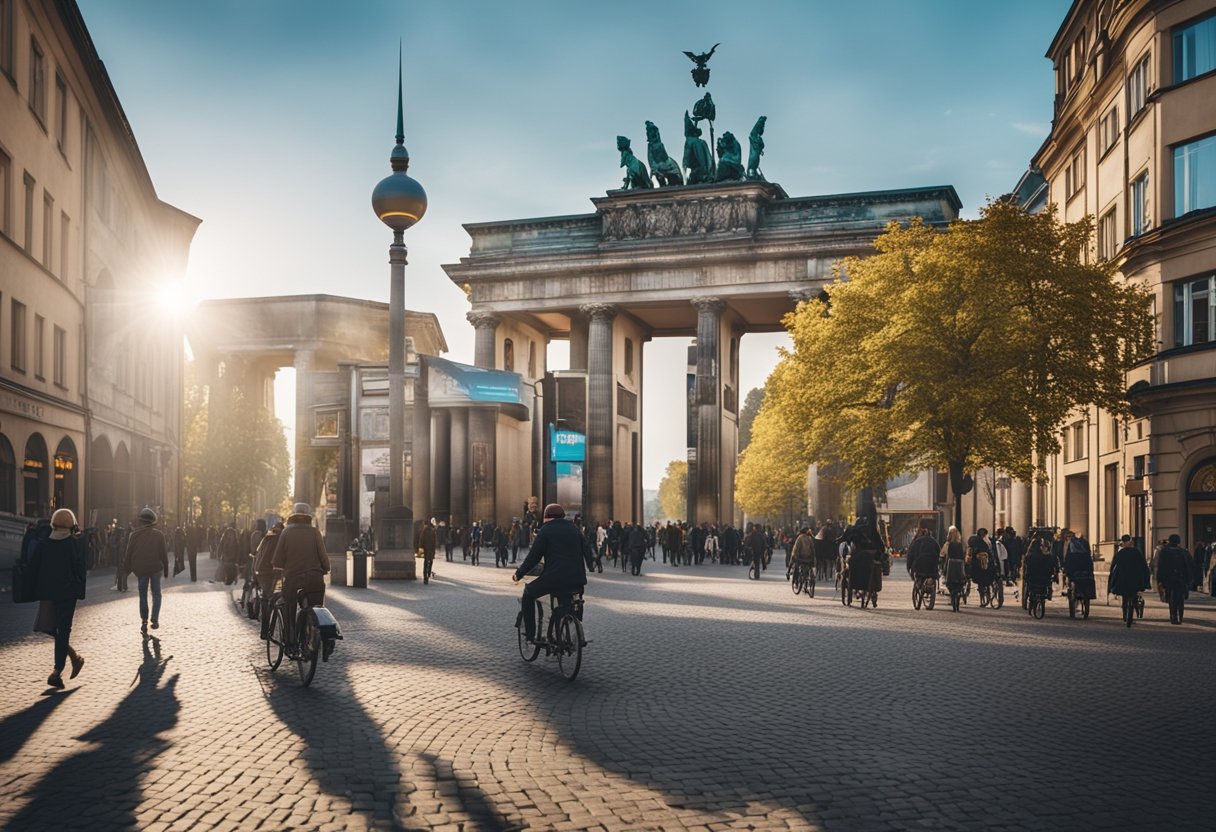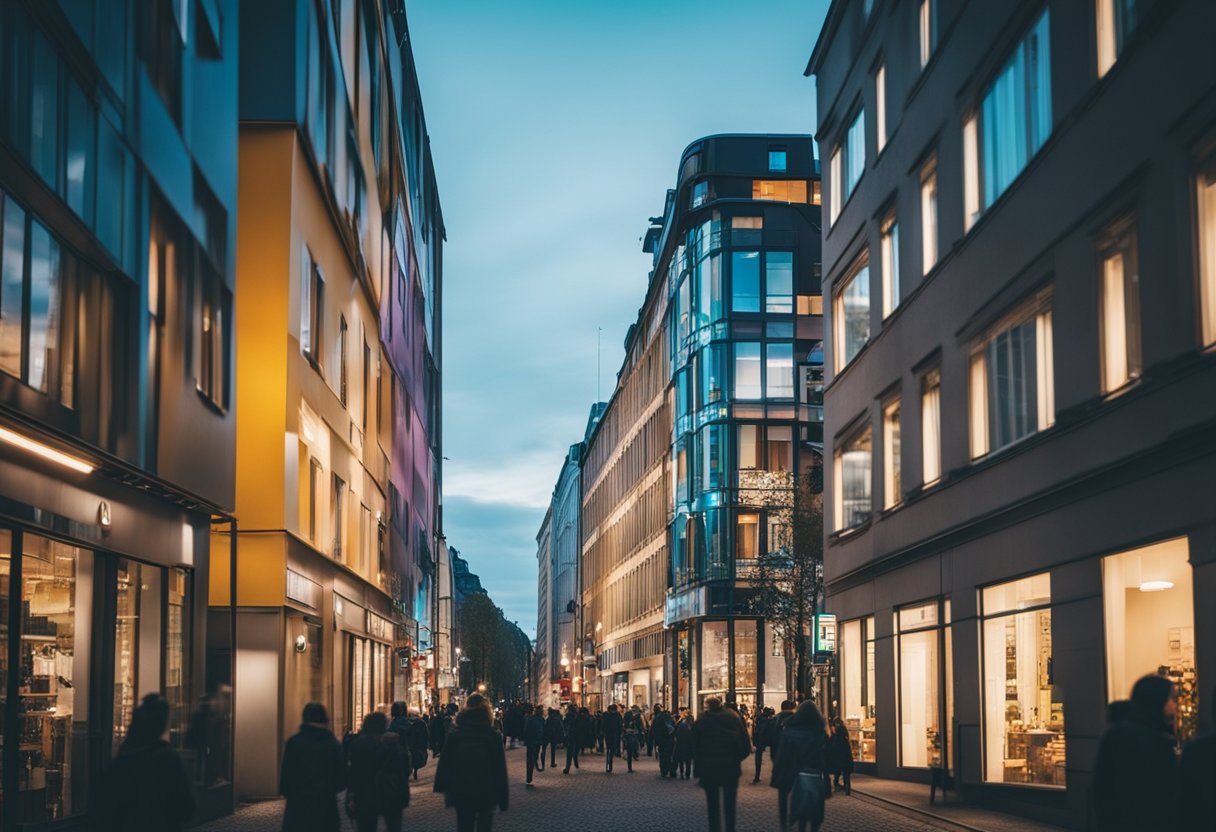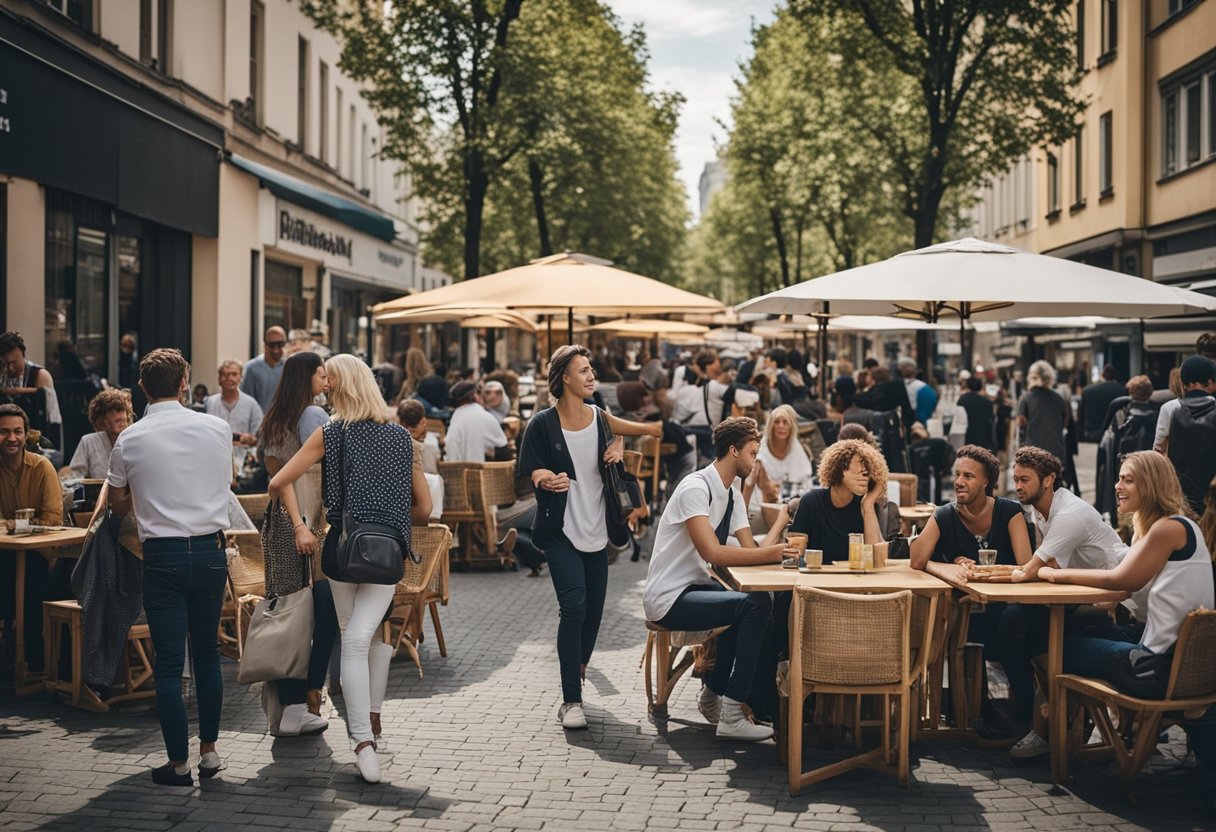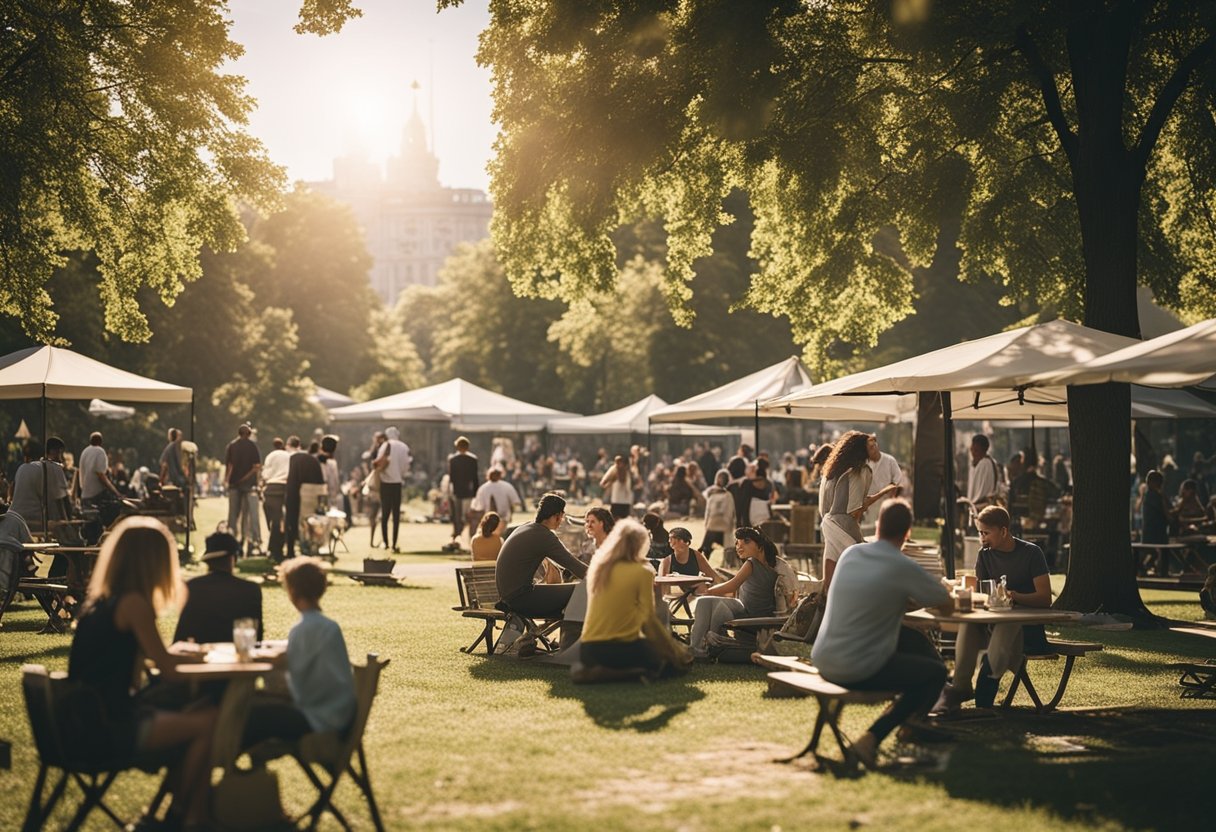When considering a new city to call home, many of us look for a place that strikes a balance between the excitement of urban life and the comfort of community living.
It is not an easy decision, but hopefully, I can help you come to a verdict.
Berlin, a city steeped in history and culture, often emerges as an attractive option for expatriates and locals alike looking for that balance. Renowned for its vibrant arts scene, diverse population, and reputation for a high quality of life, Berlin invites us to explore a rich tapestry of experiences, ranging from its cutting-edge nightlife to its peaceful parks and neighborhoods.
- Approximately 85% of Berlin’s population actively engages in cultural and artistic activities.
- The city boasts more than 2,500 parks and green spaces, offering ample opportunities for outdoor recreation.
- Berlin has over 800 clubs and bars, making it a vibrant nightlife destination.
- Around 95% of expatriates living in Berlin report high levels of satisfaction with the city’s entertainment options.
- Berlin hosts over 200 music festivals annually, catering to various genres and tastes.
Is Berlin a fun city to live in? As with any major city, living in Berlin presents an array of pros and cons that one should weigh carefully. Affordability can be a significant advantage, as many find the cost of living reasonable compared to other European capitals. The city’s public transportation system is often commended for its efficiency, making commutes and explorations an easy part of daily life. However, challenges such as navigating the bureaucracy or the local real estate market can test our patience, especially if we are not fluent in German. Furthermore, Berlin’s weather, with its cold winters, may not be to everyone’s liking.
Our collective experience has shown that Berlin’s social environment is notably welcoming and open-minded, which greatly enhances its fun quotient. The city is celebrated for its inclusivity, drawing creative minds and international residents who contribute to its cosmopolitan flare. Whether we immerse ourselves in the city’s historical heritage, engage with its artistic movements, or simply enjoy the plethora of cafes and eateries, Berlin indeed offers a dynamic setting that many of us find fulfilling and enjoyable to live in.
Cultural Richness and Artistic Scene
https://www.youtube.com/watch?v=3Q7NrkwyADE&embed=true
Berlin’s cultural tapestry is one of vibrant diversity, juxtaposing esteemed institutions with uninhibited street expression. Our city is celebrated for its rich art scene and the freedom that fuels its cultural heartbeat.
Prominent Art Galleries and Museums
Berlin is a treasure trove of art, encompassing a wide spectrum from classical masterpieces to contemporary works. The Gallery District in Mitte boasts esteemed spaces like C/O Berlin and Alte Nationalgalerie. Museums, such as the Hamburger Bahnhof and the Berlinische Galerie, chronicle our city’s rich artistic history and contemporary pulse, exhibiting works by both historical German artists and modern visionaries.
Street Art and Creative Freedom
The streets of Berlin serve as a canvas for artists, displaying the city’s commitment to creative freedom. Iconic murals, like the East Side Gallery‘s remnants of the Berlin Wall, tell stories of our past, while neighborhoods like Kreuzberg and Friedrichshain showcase dynamic street art that continually transforms our urban landscape. This raw, expressive medium stands as a testament to Berlin’s liberal atmosphere and the acceptance of diverse artistic voices.
Music and Nightlife Vibes
Our city’s nightlife is a pulsating tribute to a broad spectrum of musical genres, hosting legendary clubs like Berghain and Watergate that have become pilgrimages for electronic music aficionados. Live music venues, jazz bars, and the famous Berlin Philharmonie cater to every taste, underpinning the city’s status as a nexus of musical innovation. The interplay between techno beats and classical chords captures the essence of Berlin’s eclectic and inclusive cultural scene.
Diverse Cultural Districts
The rich tapestry of Berlin’s districts reflects our city’s pluralistic cultural identity. Areas such as Charlottenburg—with its sophisticated charm—and Prenzlauer Berg—renowned for its bohemian spirit—exemplify the city’s cultural diversity. Each district contributes its unique vibe to Berlin’s overall cultural mosaic, fostering environments where freedom of expression flourishes and artists of all stripes can thrive.
Living Essentials and Cost
In Berlin, we’re looking at a dynamic housing market and varied cost of living expenses that include essentials such as housing, groceries, and healthcare. Let’s explore each aspect to understand what living in this vibrant city entails financially.
Housing Market and Apartment Options
Berlin’s housing market offers diverse apartment options, catering to different preferences and budgets. Renting a room in a shared apartment, or WG (Wohngemeinschaft), might range from €400 to €700 per month depending on factors like location and amenities. For solo dwellers seeking their own space, a one-bedroom apartment in the city center could cost on average around €750 to €1,500 per month, while the same outside the center tends to be cheaper.
Affordability and Cost of Living
Our cost of living here is influenced by various expenses, with housing being a significant part. However, compared to other major European cities, Berlin is considered relatively affordable.
You can expect monthly expenses for a single person to be approximately €1,200 to €2,000, depending on whether you live in the central part or in the suburbs, including rent, utilities, and basic lifestyle activities, which provide a good balance of affordability and quality of life.
Shopping and Local Groceries
Groceries in Berlin’s local markets and supermarkets represent a fair share of our monthly expenditures. On average, we might spend around €200 to €300 monthly on food shopping. Prices can vary, but generally, supermarkets like Aldi and Lidl offer cheap options, while organic food stores and weekly farmers’ markets provide a range of higher-quality, although slightly pricier, alternatives.
Healthcare and Insurance Details
Health insurance is an essential consideration for living in Berlin. The cost of health insurance is often determined by income and can be as high as €725 per month for freelancers, while for full-time employees this amount is roughly €362 with a cap for higher earners.
It’s mandatory to have health insurance in Germany, and options include both public and private insurers providing comprehensive coverage, making sure our healthcare needs are well looked after.
Neighborhoods and Where to Live
When considering a move to Berlin, we’re often intrigued by its diverse neighborhoods, each offering a unique living experience.
We’ll explore some of the most sought-after areas for young professionals, the best districts for families, and the neighborhoods that exude historic charm. I personally recommend moving a couple of times because at the beginning it might be fun to be where the tourists are but after one year you might be ready to change.
Trendy Areas for Young Professionals
Kreuzberg is a perennial favorite among young professionals. It is a district that’s synonymous with Berlin subculture, playing host to an array of trendy cafes, vibrant music venues, and innovative startups. The area is trendy, gentrified, and fun, with plenty of unusual places to explore.
Mitte, the heart of Berlin, is not only the city’s historical center but also a magnet for young professionals looking for a dynamic urban environment. Housing here ranges from modern apartments to stylish lofts, often within walking distance of Berlin’s top businesses and cultural institutions.
Family-Friendly Districts
Prenzlauer Berg, once heralded as the central borough for the counterculture scene, has matured into one of the most family-friendly areas in Berlin. With its playgrounds, creches, clean streets, and friendly vibe, it’s a haven for families.
Zehlendorf offers a quieter, more suburban atmosphere with excellent schools, spacious homes, and ample green spaces, suitable for those looking to raise a family in a tranquil setting. Connectivity to the city center is good, assuring a balance between urban convenience and residential calm.
Historic Neighborhoods with Old Charm
Charlottenburg is renowned for its old-world elegance and historic architecture. The area boasts grand old buildings, sophisticated shopping on Kurfürstendamm, and cultural icons like the Charlottenburg Palace, providing a glimpse into Berlin’s regal past.
Schöneberg, with its mix of modern and turn-of-the-century architecture, exudes a special historical charm. Known for its cultural diversity and community-centric atmosphere, Schöneberg is a neighborhood where history and modernity coalesce.
Selecting where to live in Berlin hinges on individual preferences and needs. Each neighborhood presents its own character and amenities, so whether we’re looking for dynamic nightlife, family-friendly environments, or historical ambiance, Berlin’s mosaic of districts has something special to offer.
Transportation and Mobility
In exploring Berlin’s appeal, we must consider its robust transportation and mobility options that seamlessly integrate public transport, cycling pathways, and the needs of expats.
Efficiency of Public Transport
Berlin’s public transportation is a model of efficiency, encompassing various modes such as buses, trams, the U-Bahn (subway), and the S-Bahn (above ground trains). With extensive routes that cover even the outer districts, we find convenience and reliability at the core of the city’s transit system. For instance, you can traverse the city’s vast expanse, which is sizeable at 9 times that of Paris, using the well-organized network of public transport.
Bike-Friendly Routes and Cycling Culture
Our city is known for its green initiatives, and this extends to transportation. Cycling in Berlin is not just a mode of transport; it’s part of the city’s culture, embraced for its eco-friendliness and health benefits. Numerous bike-friendly routes connect parks and neighborhoods, letting cyclists navigate the cityscape with ease. Additionally, Berlin’s infrastructure developments are continuously improving to support the cycling community, ensuring that choosing a bike over a car is not only possible but enjoyable.
Accessibility for Expats and English Speakers
We recognize the diversity of Berlin, which includes a sizeable expat community. It’s reassuring that Berlin’s transportation system caters well to English speakers, with multilingual signage and announcements across public transportation. What’s more, expats find that navigating the city’s extensive transport network is manageable even without proficiency in German, which greatly eases the transition for newcomers.
Social Life and Integration
In Berlin, we find a vibrant social scene characterized by a diverse, active expat community and ample opportunities for making new connections. Navigating the nuances of language can challenge integration, but proactive engagement in the city’s networks eases this transition.
Expat Communities and Networking
The expat community in Berlin is thriving, providing a solid network for newcomers seeking to integrate. Numerous groups and events cater specifically to expatriates, including cultural, recreational, and professional meetups. Websites like Meetup and Facebook groups are prime resources for finding expat-related gatherings. Professional networking events are also prevalent, often conducted in English, which facilitates easier communication for those still grappling with the German language.
Meeting People and Making Friends
Berlin is a city where we can make friends in settings ranging from casual cafe encounters to structured social clubs. The capital’s open-minded atmosphere encourages us to step out and connect with people from all over the world. For instance, communities like Internations and various sports clubs provide structured environments to foster friendships. Moreover, Berlin’s nightlife and cultural events are perfect for meeting locals and foreigners alike, making the process of finding friends more enjoyable.
Language Barriers and Communication
Although Berlin is an international city, we cannot disregard the German language as a key component of full integration. Expats who learn German report feeling more at home and find it easier to establish deeper connections locally. While English is widely spoken, especially amongst younger Berliners and in professional environments, having a grasp of German is invaluable. Language exchange meetups and German classes, such as those provided by Volkshochschule, are available to help us conquer language barriers, enriching our experience in Berlin and allowing for more effective communication on all fronts.
Leisure and Recreation
Berlin is unmatched in its variety of leisure and recreation options, from lush parklands and buzzing nightlife to diverse shopping venues. We invite you to explore the city‘s multifaceted areas for relaxation, socializing, and entertainment.
Parks, Gardens, and Outdoor Activities
Berlin takes pride in its extensive array of green spaces, with over 2,500 parks and gardens that offer a slice of nature and tranquility. Tiergarten serves as the city’s green lung, a sprawling central park where joggers, cyclists, and picnic enthusiasts gather. For those who seek activities by the water, the banks of Lake Wannsee provide the perfect setting for a range of water sports and leisurely strolls. Outdoor activities are a significant part of life here, as noted in a BitGlint article, emphasizing the city’s commitment to connecting people with nature.
Cafes, Bars, and Restaurant Overview
We find that Berlin’s culinary scene is as diverse as its population, offering everything from cozy cafes to vibrant bars and restaurants. Kreuzberg and Neukölln are trendy neighborhoods where the streets are lined with eateries of all cuisines and price points. Berlin’s bar scene is renowned across Europe, offering a plethora of options from laid-back beer gardens to high-energy clubs. Sites like Talent Berlin highlight the city’s vast assortment of places to unwind after work or enjoy a lively night out.
Shopping Destinations and Flea Markets
When it comes to shopping, Berlin’s retail landscape caters to a wide range of tastes and budgets. Shopping enthusiasts can browse everything from high-end boutiques on Kurfürstendamm to the eclectic stalls of Mauerpark Flea Market. With nearly 50 flea, art, and antique markets, highlighted by Expat.com, treasure hunters and casual shoppers alike will find unique items and memorable experiences. Whether looking for the latest fashion trend or a one-of-a-kind vintage piece, our city’s shopping destinations provide endless opportunities.
Historical Context and Education
In our exploration of Berlin, we must acknowledge its rich historical tapestry and robust educational framework. Let us guide you through the historical significance of the Berlin Wall and the city’s history, as well as the opportunities Berlin offers to students and professionals through its educational institutions.
Berlin Wall and City History
Berlin’s history is deeply interwoven with the existence and fall of the Berlin Wall. For nearly three decades, this concrete barrier not only divided the city physically but also stood as a symbol of the Cold War, separating East and West Germany from 1961 until 1989. Today, remnants of the wall and various related sites serve as poignant reminders and educational resources. These memorials recount stories of the city’s division and its path to reunification, illustrating critical chapters in not only German history but also in the greater narrative of global politics.
Educational Institutions for Students and Professionals
When it comes to education, Berlin is lined with numerous institutions that cater to a range of disciplines for both students and professionals. Prestigious universities like the Humboldt-Universität zu Berlin and the Technische Universität Berlin attract students globally, offering courses that range from humanities to cutting-edge technology and sciences. Moreover, Berlin’s emphasis on art and culture is mirrored in its specialized schools such as the Berlin University of the Arts. Institutions here blend traditional academic environments with vocational training, preparing students for professional success in a city that thrives on innovation and culture.
Job Market and Professional Life
In evaluating Berlin’s job market, we must consider the vibrant opportunities it presents, particularly for creatives and entrepreneurs, while also acknowledging the realities of employment rates and average salaries. Berlin has positioned itself distinctively within Germany and Western Europe as a hub for innovative minds.
Opportunities for Creatives and Entrepreneurs
Berlin stands out as a magnet for creatives and those with an entrepreneurial spirit. The city boasts a flourishing startup scene, credited for driving the Berlin-renaissance since the late 00s. Numerous artists, professionals, and innovators are drawn to the city for its open-minded culture and dynamic economy. This environment provides fertile ground for both budding and established entrepreneurs looking to bring fresh ideas to life.
Employment Rates and Average Salaries
Berlin’s employment landscape, while attractive in many sectors, presents challenges. Although the city’s unemployment rate has seen fluctuations, it remains pivotal to have skills in demand to enhance job prospects. Sectors such as tech, the creative industries, and business services lead in job creation. However, potential residents should be aware that average salaries in Berlin are often lower than in other Western European cities, a trade-off for what is generally a lower cost of living.
Quality of Life and Safety
Before we delve into specifics, it’s essential to recognize that Berlin’s reputation as the German capital contributes significantly to its high quality of life and safety standards, appealing to both families and individuals alike.
Overall Safety and Security
Berlin is known to be a safe city with a low crime rate compared to other major cities. The comprehensive healthcare system, efficient law enforcement, and a general sense of communal responsibility ensure that residents feel secure. It is vital for us to acknowledge the law enforcement’s dedication to maintaining a safe environment for all inhabitants.
Family Life and Child-Friendly Amenities
The city offers a harmonious lifestyle suitable for family life, with numerous parks, playgrounds, and schools that cater to children of all ages. Families can benefit from well-structured educational systems and a variety of child-friendly activities and community centers, positioning Berlin as an environment conducive to raising children.
Pet Policies and Dog-Friendly Spaces
As a dog-friendly city, Berlin’s parks often welcome pets, with specific areas designated for dogs to play without a leash. Our canine companions are also allowed in many public spaces, including some cafes and stores. This makes Berlin a city considerate of pet owners and their furry friends, factoring them into the city’s inclusive policies.
Food and Dining Scene
Berlin’s food scene is a vibrant tapestry of flavors, ranging from traditional German fare to a myriad of international options. Here, diversity is not just an attribute—it’s a culinary standard.
Local Delicacies and Street Food
Berlin is renowned for its street food, which includes the iconic currywurst—a steamed and fried pork sausage, typically cut into slices and seasoned with curry ketchup, usually accompanied by a roll or fries. Moreover, Turkish influences are evident, with doner kebabs standing as a testament to the city’s multicultural palate. One must-visit example includes Mustafa’s Gemüse Kebap, known for their legendary kebabs with grilled vegetables.
International Cuisines and Diverse Offerings
Our exploration of Berlin’s culinary breadth isn’t complete without acknowledging the variety of international cuisines present in the city. Restaurants in Berlin offer an array of global flavors, reflecting the city’s international community. From cozy Italian trattorias to bustling Vietnamese markets, there’s no shortage of options for those craving diversity. Visitors and locals alike can experience the creative dining scene that’s still going strong, as highlighted by Forbes, with innovative restaurants that continue to push the envelope.
Legal and Administrative Affairs
In embracing Berlin as your new home, we are aware that navigating through legal and administrative procedures is crucial for a seamless transition. It requires an understanding of visa requirements, residency regulations, and setting up essential services like utilities and internet.
Visa Requirements and Residency Regulations
We must first ensure our stay is legitimate and in line with the German legal framework. Non-EU expats will need to secure an appropriate visa before moving to Berlin; this could range from work to student visas, depending on your intentions in the city. Upon arrival, registering your residence—known as the Anmeldung—is mandatory and acts as a gatekeeper to other services like healthcare and a bank account. For detailed guidance on completing your Anmeldung and the visas required for staying in Berlin, information is available on Living in Berlin in 2023.
Setting Up Utilities and Internet
Once we have our visa and residency sorted, we need to establish basic services. Setting up utilities is straightforward; you’re typically looking at electricity, water, and waste disposal, which can be managed through local providers. For internet, Berlin offers several high-speed options. The key is to compare providers to find a suitable package that matches our needs in terms of speed, data, and reliability. Internet setup is essential for staying connected, and for expats, this often means keeping in touch with family or working remotely. Check out Administration Berlin for steps on how to get started with these services.
Real Estate and Renting
When considering a move to Berlin, it’s important for us to understand the dynamics of the local real estate market and the essentials of the renting process, including our rights as tenants. We’ll explore current trends in Berlin’s housing market and what we should expect when looking to rent an apartment.
Real Estate Market Trends
Berlin’s property market has seen significant fluctuations over the last few years, with rental prices raising due to increased demand and urban development. Well-equipped shared student apartments“> are available, but even those have seen a push in pricing. Many neighborhoods have transitioned from low-cost housing areas to more upscale markets.
- Average Rent for an Apartment: €800-1050
- Utilities: €150-200
- Areas with Highest Demand: Friedrichshain-Kreuzberg, Mitte, and Prenzlauer Berg
Renting Processes and Tenant Rights
The process for renting apartments in Berlin involves several steps. Usually, we must view the property, submit an application, and, if accepted, sign a lease agreement. Leases often require a security deposit, typically equivalent to three months’ rent. As tenants in Berlin, we have considerable rights, including protection against unjust eviction and the right to a rent reduction if the apartment has significant issues.
- Application Documents: Proof of income, credit report, ID/passport
- Tenant Rights: Repair services, privacy, right to remain in the property unless breached contract terms
It’s helpful to note that fluency in German can be an advantage during this process, as some landlords may prefer tenants who can communicate easily without a language barrier. However, services are available that can support us in multiple languages if needed.
Costs and Expenses
When considering a move to Berlin, we need to closely evaluate the cost of living and how it stacks up against other cities. This includes day-to-day expenses, as well as how much we should allocate for enjoying the city’s offerings and those unpredictable costs that inevitably arise.
Living Costs Comparison with Other Cities
Berlin, while the most expensive city in Germany, still offers a lower cost of living compared to many western European capitals. A family of four’s estimated monthly costs are around €5,061, while a single person’s costs are approximately €2,828. Compared to other cities, these costs are significantly less than those in London or Paris. For example, living in Berlin is cheaper than living in 81% of cities in Western Europe. To put this into perspective, here’s how Berlin measures against other cities in specific living expenses:
- Rent: In comparison to cities like London, rent in Berlin can be up to 50% lower.
- Groceries: Berlin’s supermarket prices are generally lower than in Nordic countries.
- Transportation: The city’s efficient public transport system is more affordable than many other European metro systems.
Information via Expatistan.
Budgeting for Leisure and Unexpected Expenses
Our budget must account not just for necessities but also for leisure, which in Berlin can vary greatly depending on personal interests and lifestyle choices. To enjoy the city’s vibrant cultural scene, eating out, and nightlife, individuals can expect to spend an additional €200 to €300 monthly. It is also wise for us to set aside funds for unexpected expenses, as they are part and parcel of life. To this end, ensuring a buffer of around €100 to €200 in our monthly budget could help in managing any unforeseen costs without stress.
The monthly costs for leisure and unexpected expenses are averages and can be adapted based on personal necessity and the lifestyle one chooses in Berlin. Details about expenses were gathered from The Berlin Life and Nomad and in Love.
Advantages and Challenges of Relocation
When considering a move to Berlin, we must weigh both the cultural enrichments that await expatriates and the economic realities, including the job market conditions.
Cultural Advantages for Expatriates
Berlin stands as a beacon of cultural vibrancy within Germany, offering expatriates a rich tapestry of artistic and historical experiences. We find that the city’s wealth of museums, theaters, and galleries, along with its diverse musical landscape, provides a stimulating environment for those seeking to immerse themselves in culture. The lifestyle in Berlin is appealing to many expatriates due to an excellent healthcare system, efficient public transportation, and a plethora of recreational activities. You might also appreciate Berlin’s unique character, evident in the distinct personality of each neighborhood.
Challenges of High Unemployment and Job Searching
Despite its attractions, Berlin presents certain hurdles. One significant challenge is the city’s higher unemployment rates compared to other German cities. This can make job searching a daunting task, especially for those looking to work within certain industries. Moreover, though there are opportunities for English-speaking jobs, the competition is fierce, and wages can be lower than in other major European cities. Therefore, securing employment before moving can alleviate some of the uncertainties associated with relocating to Berlin.
